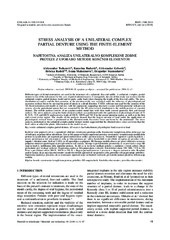Приказ основних података о документу
Stress analysis of a unilateral complex partial denture using the finite-element method
| dc.creator | Todorović, Aleksandar | |
| dc.creator | Radović, Katarina | |
| dc.creator | Grbović, Aleksandar | |
| dc.creator | Rudolf, Rebeka | |
| dc.creator | Maksimović, Ivana | |
| dc.creator | Stamenković, Dragoslav | |
| dc.date.accessioned | 2020-07-02T12:28:05Z | |
| dc.date.available | 2020-07-02T12:28:05Z | |
| dc.date.issued | 2010 | |
| dc.identifier.issn | 1580-2949 | |
| dc.identifier.uri | https://smile.stomf.bg.ac.rs/handle/123456789/1550 | |
| dc.description.abstract | Different types of dental restorations are used in the treatment Of a unilateral, free-end saddle. A unilateral, complex, Partial denture is one of (lie indications for this case of partial edentulousness. Consequently, the aim Of this Study was to stress test the unilateral complex partial denture model and its parts, under load, when changing the length of thee free-end saddle. The stress distribution in canines and the first premolar, as the retention teeth. was examined under the influence of physiological and excessive occlusal forces by moving the point of attack in a distal direction. CATIA software was used for the creation of the 3D. Fixed restoration unit model, in real size, with the appropriate Supporting structures (canine and first premolar with present crowns, alveola. periodontal space) that are connected by the SD snap-in-latch attachment to the mobile portion of a partial denture. The mobile portion consists of in acrylate-coated metal base with three teeth (second premolar, first and second molars). The stress analysis, using the finite-element method, was performed Under the application of physiological loads of 25 N, 50 N. 75 N and 100 N, and excessive loads of 300 N, 500 N and 700 N in the second premolar region, as well as in the first and second molar region. The results of the analysis showed that the largest amount Of load under the application of physiological occlusal forces is positioned on the abutment teeth. Excessive forces are borne by the attachment. The stress analysis, performed on the unilateral complex partial denture model. Suggested that the obtained stress values are lower than the limit values at which the plastic deformation in the model occurs. | en |
| dc.publisher | Institute of Metals and Technology | |
| dc.rights | openAccess | |
| dc.source | Materiali in Tehnologije | |
| dc.subject | unilateral complex partial denture | en |
| dc.subject | SD snap-in-latch attachment | en |
| dc.subject | physiological load | en |
| dc.subject | excessive load | en |
| dc.title | Stress analysis of a unilateral complex partial denture using the finite-element method | en |
| dc.type | article | |
| dc.rights.license | Publisher's own license | |
| dcterms.abstract | Рудолф, Ребека; Стаменковић, Драгослав; Тодоровић, Aлександар; Максимовић, Ивана; Грбовић, Aлександар; Радовић, Катарина; | |
| dc.citation.volume | 44 | |
| dc.citation.issue | 1 | |
| dc.citation.spage | 41 | |
| dc.citation.epage | 47 | |
| dc.citation.other | 44(1): 41-47 | |
| dc.citation.rank | M23 | |
| dc.identifier.wos | 000275263700008 | |
| dc.identifier.scopus | 2-s2.0-79851497288 | |
| dc.identifier.fulltext | https://smile.stomf.bg.ac.rs/bitstream/id/332/1545.pdf | |
| dc.identifier.rcub | https://hdl.handle.net/21.15107/rcub_smile_1550 | |
| dc.type.version | publishedVersion |


